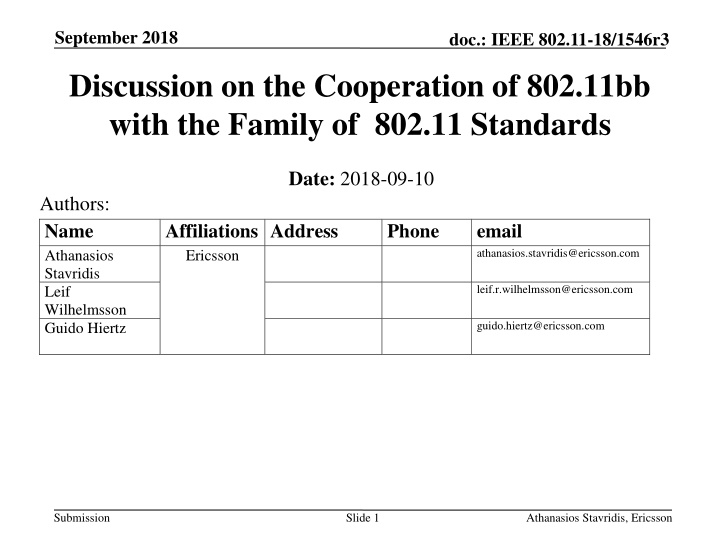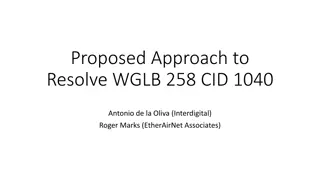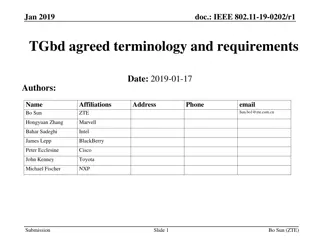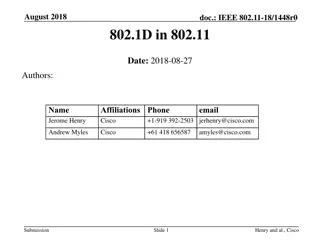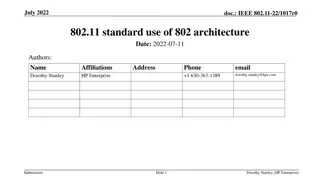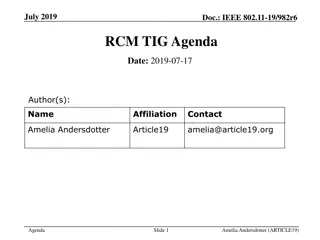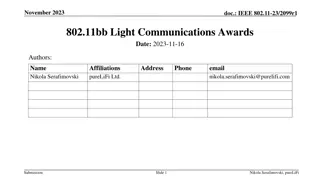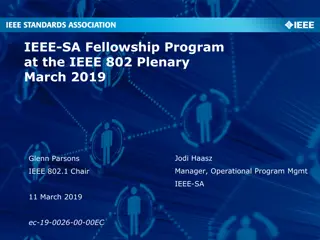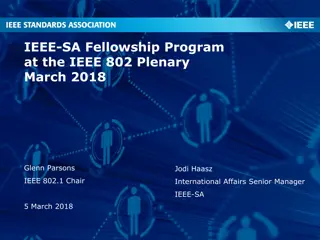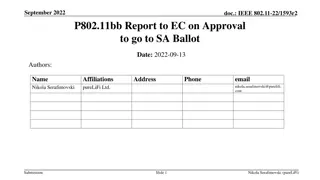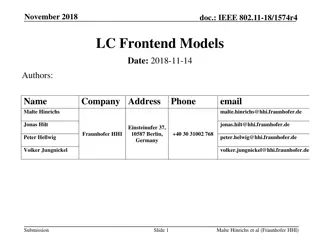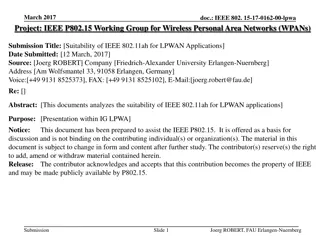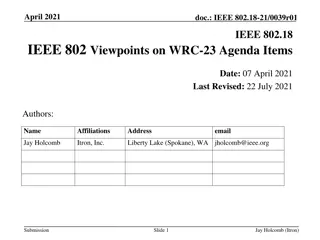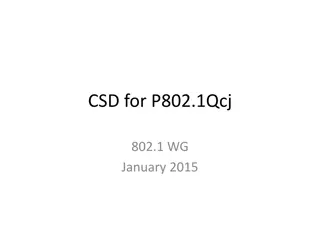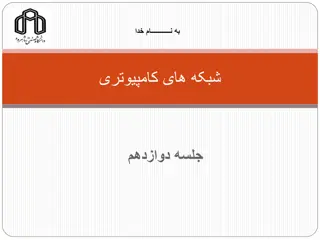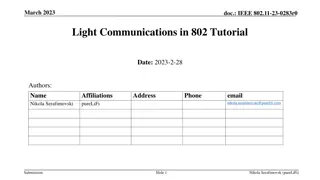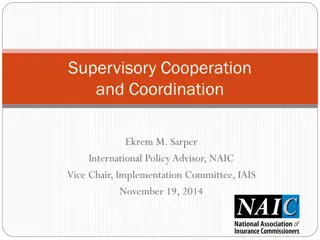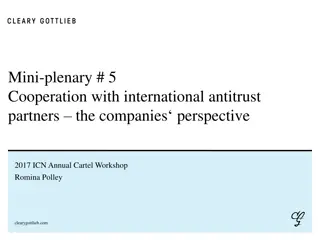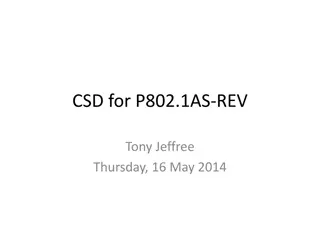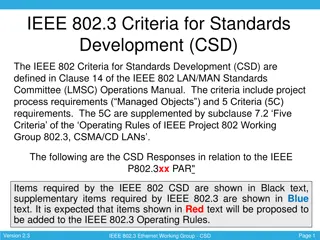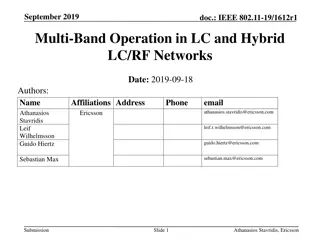Cooperation of IEEE 802.11bb with Family of 802.11 Standards
Discusses addressing outage problems in usage models when signal blockage occurs or setup is unfavorable, utilizing Fast Session Transfer mechanism and cooperation with IEEE 802.11 standards for RF communication to accelerate market penetration.
Uploaded on Mar 18, 2025 | 1 Views
Download Presentation

Please find below an Image/Link to download the presentation.
The content on the website is provided AS IS for your information and personal use only. It may not be sold, licensed, or shared on other websites without obtaining consent from the author.If you encounter any issues during the download, it is possible that the publisher has removed the file from their server.
You are allowed to download the files provided on this website for personal or commercial use, subject to the condition that they are used lawfully. All files are the property of their respective owners.
The content on the website is provided AS IS for your information and personal use only. It may not be sold, licensed, or shared on other websites without obtaining consent from the author.
E N D
Presentation Transcript
September 2018 doc.: IEEE 802.11-18/1546r3 Discussion on the Cooperation of 802.11bb with the Family of 802.11 Standards Date: 2018-09-10 Authors: Name Athanasios Stavridis Leif Wilhelmsson Guido Hiertz Affiliations Address Ericsson Phone email athanasios.stavridis@ericsson.com leif.r.wilhelmsson@ericsson.com guido.hiertz@ericsson.com Submission Slide 1 Athanasios Stavridis, Ericsson
September 2018 doc.: IEEE 802.11-18/1546r3 Abstract Most of the usage models of [1,2] face outage problems when a physical optical signal blockage occurs or the geometric setup of the transceiver is unfavourable. This contribution discusses ways to address this problem by using the Fast Session Transfer (FST) mechanism of IEEE STD 802.11-2016 [3] and rely on the already available IEEE 802.11 family of standards for RF communication. The cooperation of IEEE 802.11bb with the rest of the family of standards of IEEE 802.11 has the potential to accelerate the penetration of LC in the general market of IEEE 802.11. Submission Slide 2 Athanasios Stavridis, Ericsson
September 2018 doc.: IEEE 802.11-18/1546r3 Outline Recap of the usage models of IEEE 802.11bb Possible difficulties encountered by LC systems Possible countermeasures and solutions Multi-band Operation and the Fast Session Transfer Mechanism (FST) as a way forward Advantages of the cooperation of 802.11bb with the rest of the 802.11 standards Conclusion Submission Slide 3 Athanasios Stavridis, Ericsson
September 2018 Recap of the Usage Models of IEEE 802.11bb doc.: IEEE 802.11-18/1546r3 In IEEE 802.11bb, the following usage models are considered [1]: Industrial wireless (10 Mbps-1 Gbps; latency <1 ms; 99.9 % reliability) Wireless access in medical environments (10 Mbps-3 Gbps, latency<1 ms) Enterprise networks wireless (10 Mbps-1 Gbps; latency <1 ms) Home networks wireless (10 Mbps-5Gbps; latency<1 ms) Also, the following secondary usage models are considered [2]: Backhaul V2V, V2I, and I2V communication Underwater communication Gas Pipeline communication Submission Slide 4 Athanasios Stavridis, Ericsson
September 2018 Possible Difficulties Encountered by LC Systems doc.: IEEE 802.11-18/1546r3 In LC and especially in the visible light spectrum: The optical wireless channel is highly dependent on the geometric setup of the (MIMO) transceiver [4,5,6]. This means that an inconvenient geometric setup results in the rapid decrease of the receive optical SINR Physical signal blockage causes connectivity problems In particular, almost all considered usage models of IEEE 802.11bb are susceptible to the previous events Submission Slide 5 Athanasios Stavridis, Ericsson
September 2018 doc.: IEEE 802.11-18/1546r3 An Optical Solutions (1) A solely optical solution requires the careful deployment of multiple optical transmitters, in different spatial positions and with different orientations, and multiple photo-detectors in the receiver with different orientations. Ideally, the multiple photo-detectors have also different spatial positions. Problems: The densification of the optical transmitter might cause undesired optical interference. Additional backhauling is required. On-the-fly system adaption is difficult. Submission Slide 6 Athanasios Stavridis, Ericsson
September 2018 doc.: IEEE 802.11-18/1546r3 An Alternative Solutions (2) An alternative solution can be based on the cooperation of LC and RF communication systems. Operating principle: In the event of blockage or low values of receive SINR, LC is terminated and data transmission is direct to the existing RF wireless network. Once LC is possible, data transmission is redirected to the existing LC wireless network. Main advantage: As 802.11bb is part of the 802.11, its cooperation with the rest of the 802.11 standards can be done efficiently using already existing mechanisms and with almost negligible standard modification. Submission Slide 7 Athanasios Stavridis, Ericsson
September 2018 Multi-band Operation and the Fast Session Transfer Mechanism (FST) as Way Forward doc.: IEEE 802.11-18/1546r3 Based on IEEE STD 802.11-2016 [3], a multiband capable device is able to: manage operations in more than one band/channel in a simultaneous manner or not. support multiple MAC sublayers. In IEEE 802.11, the FST mechanism presented in IEEE STD 802.11-2016 [3], is the mechanism which enables multiband operations. A FST mechanism from IEEE STD 802.11-2016 [3] could be also be used by IEEE 802.11bb for enabling its cooperation with rest of the RF IEEE 802.11 standards. Result: faster and smoother penetration of LC in the wide market of IEEE 802.11 Submission Slide 8 Athanasios Stavridis, Ericsson
September 2018 doc.: IEEE 802.11-18/1546r3 Advantages of the cooperation of 802.11bb with the rest of the 802.11 standards On-the-fly increased connectivity and communication robustness for: i) industrial wireless; ii) enterprise and home networks; and iii) V2V, V2I, and I2V communication. Indirect support of high mobility in: i) industrial wireless; enterprise and home networks; and ii) V2V, V2I, and I2V communication. Coverage extension in: i) industrial wireless; ii) enterprise and home networks; and iii) V2V, V2I, and I2V communication. Cross-room connectivity in i) industrial wireless; and ii) enterprise and home networks. Enable the formation of on-the-fly unstructured LC networks in: i) industrial wireless; ii) enterprise and home networks; and iii) V2V, V2I, and I2V communication. Submission Slide 9 Athanasios Stavridis, Ericsson
September 2018 doc.: IEEE 802.11-18/1546r3 Conclusions Most of the considered usage models of [1,2] are susceptible to optical signal blockages and poor performance in unfavourable geometric setups of the involved transceivers. An optical solution might increase the system interference, requires additional backhauling, and it might not adaptable. An alternative solution can be approached by enabling the cooperation of IEEE 802.11bb with the rest of the IEEE 802.11 standards. This can be achieved using the FST mechanism of IEEE STD 802.11-2016 [3] with marginal standards modification. The discussed solution could accelerate the spread of IEEE 802.11bb in the general ecosystem of IEEE 802.11 Submission Slide 10 Athanasios Stavridis, Ericsson
September 2018 doc.: IEEE 802.11-18/1546r3 Straw Polls Do you believe that the effective cooperation of IEEE 802.11bb with the rest of the IEEE 802.11 family of standard is beneficial for IEEE 802.11bb? Y/N/A: 13/0/1 Submission Slide 11 Athanasios Stavridis, Ericsson
September 2018 doc.: IEEE 802.11-18/1546r3 References [1] 11-18/1109r5, LC Usage Model Document , Oliver Pengfei Luo, et al. [2]802.11-18/1109r2, LC Usage Model Document , Oliver Pengfei Luo, et al. [3] IEEE Standard for Information technology--Telecommunications and information exchange between systems Local and metropolitan area networks-- Specific requirements - Part 11: Wireless LAN Medium Access Control (MAC) and Physical Layer (PHY) Specifications," in IEEE Std 802.11-2016 (Revision of IEEE Std 802.11-2012) , vol., no., pp.1-3534, 14 Dec. 2016 [4] J. M. Kahn and J. R. Barry, "Wireless infrared communications," in Proceedings of the IEEE, vol. 85, no. 2, pp. 265-298, Feb. 1997. [5] A. Stavridis and H. Haas, "Performance evaluation of space modulation techniques in VLC systems," 2015 IEEE International Conference on Communication Workshop (ICCW), London, 2015, pp. 1356-1361. [6] M. Uysal, F. Miramirkhani, O. Narmanlioglu, T. Baykas and E. Panayirci, "IEEE 802.15.7r1 Reference Channel Communications," in IEEE Communications Magazine, vol. 55, no. 1, pp. 212- 217, January 2017. Models for Visible Light Submission Slide 12 Athanasios Stavridis, Ericsson
